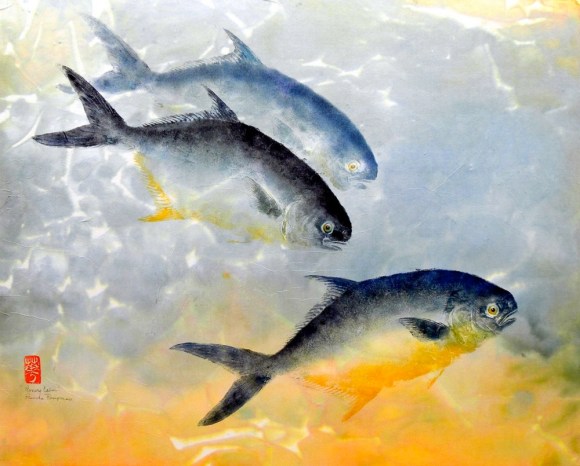
Japan has a fascinating art history. From early cord designs on clay vessels in the Jomon period (c. 11000–c. 300 BC) through to picture scrolls, ukiyo-e woodblock prints, and the distinctive style of animation that exists today, people in Japan have always found unique ways to capture the world around them for the rest of the world to see.
One little-known art technique from the 1800s is now making a comeback, and while its roots are firmly planted in Japan’s traditional history, it’s a method of printing that people all around the world can enjoy. All you need is paper, some paint and a nice-looking fish.
Called gyotaku (fish rubbing), this is the art that brings seafood to life on land, and the designs you can create are absolutely stunning. The traditional Japanese method of printing fish came about before the advent of photography, when fishermen were looking for a way to record the size and species of their catch.
While nature prints using flat objects like leaves had been around for some time, printing from the thick, curved body of a fish was an unusual but natural development, considering fishermen usually carried paper, ink and brushes on board with them while out at sea.
After catching a particularly impressive fish, fishermen would coat one side of it with ink and then cover with rice-straw paper, rubbing gently until an impression was made. The non-toxic ink was then washed off the fish so it could be sold at market, while the more revered catches were returned to the ocean.
After some time, fishermen began enhancing their prints by painting in the eyes and other details.
In Japan, gyotaku is primarily the domain of fishermen, where you’ll find prints of great catches in their homes and on the walls of fishmonger’s shops. Artists abroad, however, are taking the technique to a whole new level, creating colourful and creative underwater scenes in the same style.
Artist Heather Fortner has been creating gyotaku artworks for almost 40 years. She often uses multiple prints on the one sheet of paper for her beautiful designs.
Fortner often set up makeshift studios on board large merchant vessels while living in Hawaii, where she could use fish that had been caught or otherwise found in the markets at foreign ports.
Now based on the Central Oregon Coast, Fortner offers workshops in gyotaku, paper-making and nature-printing.
To see how she creates her beautiful artworks, take a look at her gyotaku tutorial below.
Another experienced gyotaku artist, Odessa Kelley, uses the technique with an octopus:
And now for an enormous Grouper:
That’s a quick way to make an enormous artwork!
Is this your first brush with (or should that be impression of?) gyotaku? Would you be interested in giving it a try?
Source: LINE Corporation
Top Image: Heather Fortner
Insert images: Fishing Shop Yoshioka, Heather Fortner, Heather Fortner


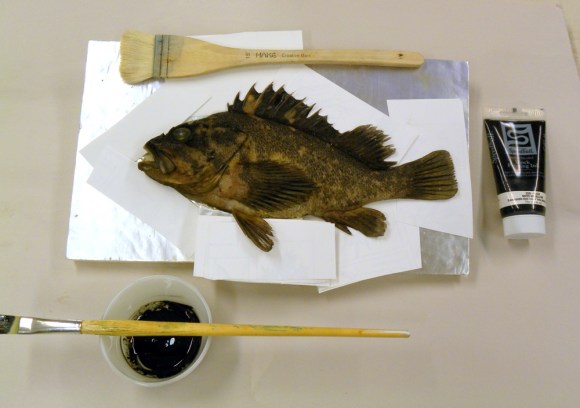
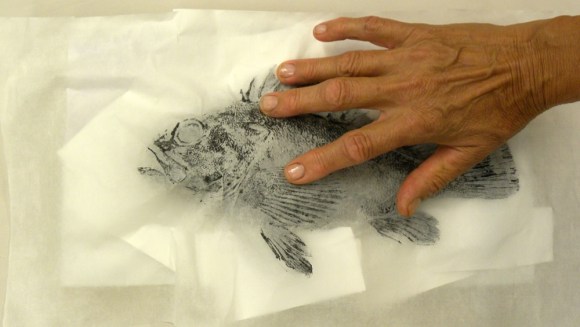
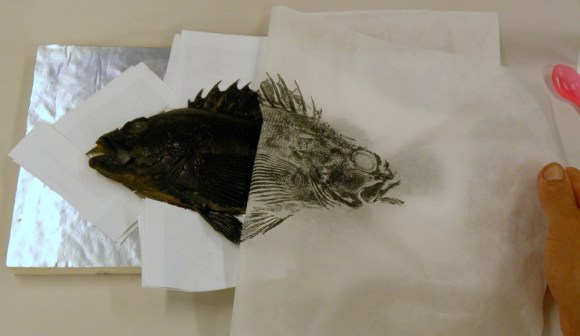
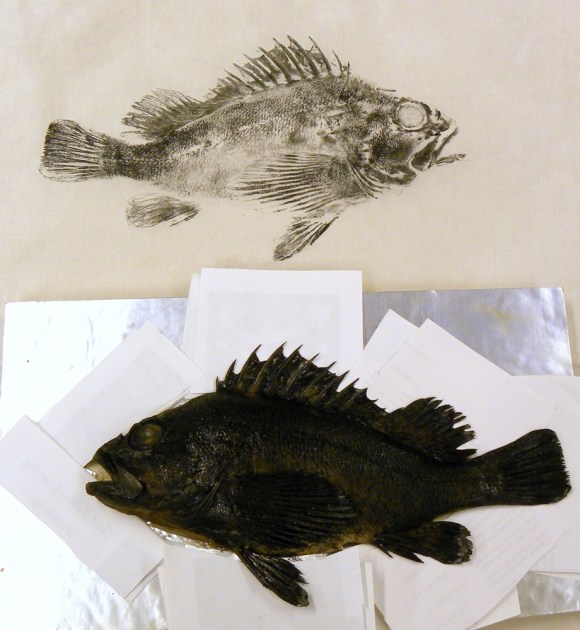
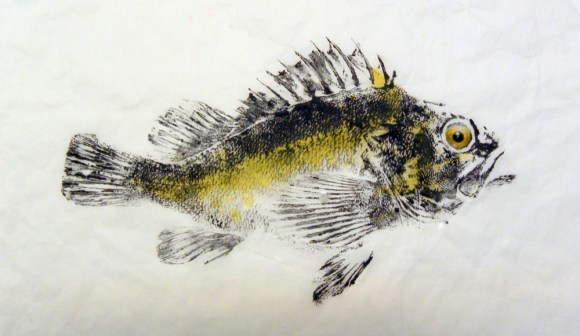
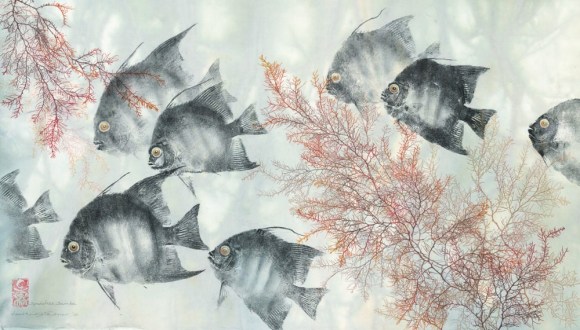
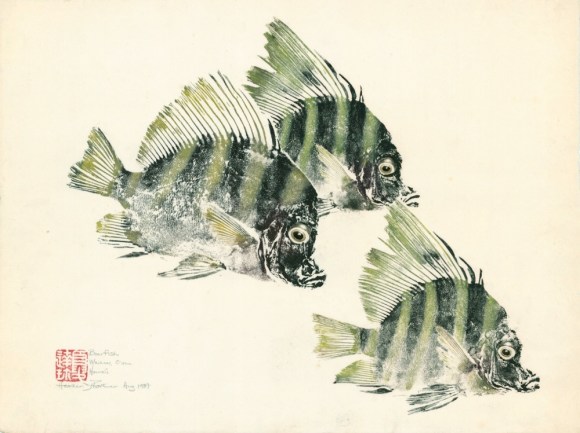
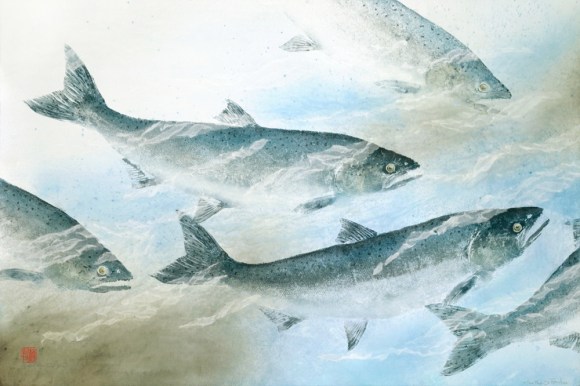
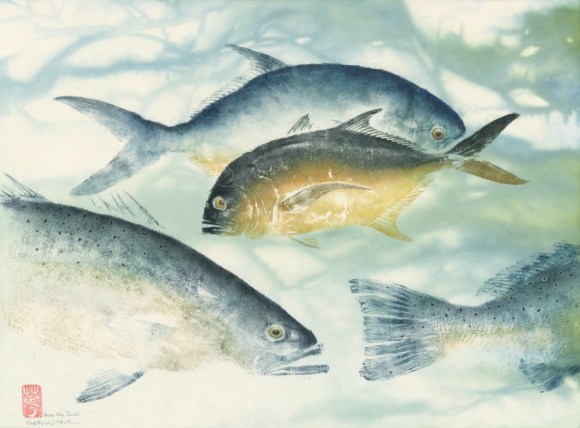
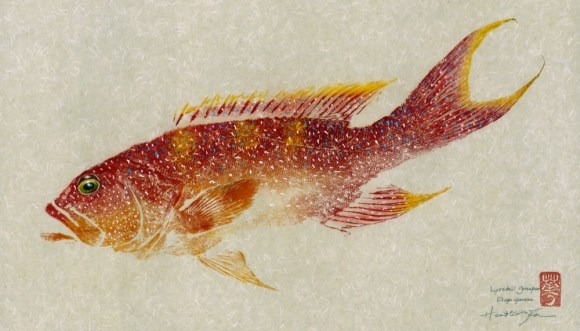
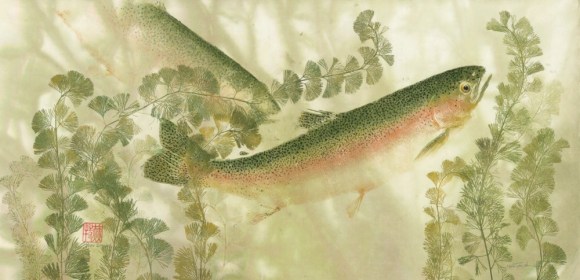
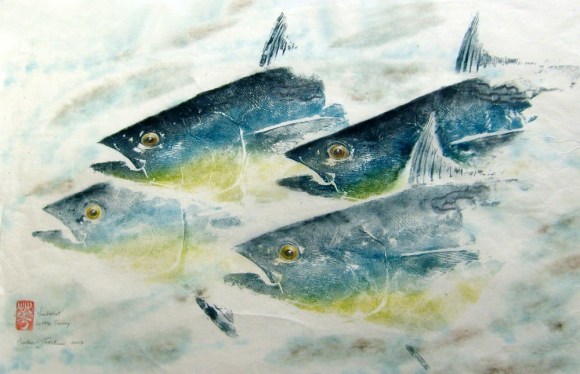
 Young Goku gets turned into adorable limited edition ukiyoe print!
Young Goku gets turned into adorable limited edition ukiyoe print! Kabuki and geisha cats appear as cute purses based on famous Japanese ukiyo-e woodblock prints
Kabuki and geisha cats appear as cute purses based on famous Japanese ukiyo-e woodblock prints Huge tuna fish sells for a whopping 190 million yen at the first wholesale auction of the year
Huge tuna fish sells for a whopping 190 million yen at the first wholesale auction of the year Japanese fashion brand Heather releases line for people 5 feet and under
Japanese fashion brand Heather releases line for people 5 feet and under Fisherman catches unreal-looking fish off the coast of Japan, turns out to be quite harmless
Fisherman catches unreal-looking fish off the coast of Japan, turns out to be quite harmless McDonald’s new Happy Meals offer up cute and practical Sanrio lifestyle goods
McDonald’s new Happy Meals offer up cute and practical Sanrio lifestyle goods Studio Ghibli glasses cases let anime characters keep an eye on your spectacles
Studio Ghibli glasses cases let anime characters keep an eye on your spectacles All-you-can-drink Starbucks and amazing views part of Tokyo’s new 170 meter-high sky lounge
All-you-can-drink Starbucks and amazing views part of Tokyo’s new 170 meter-high sky lounge Super Nintendo World expansion gets delayed for several months at Universal Studios Japan
Super Nintendo World expansion gets delayed for several months at Universal Studios Japan More foreign tourists than ever before in history visited Japan last month
More foreign tourists than ever before in history visited Japan last month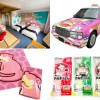 Kagawa Prefecture becoming Slowpoke Paradise this spring
Kagawa Prefecture becoming Slowpoke Paradise this spring Beautiful Sailor Moon manhole cover coasters being given out for free by Tokyo tourist center
Beautiful Sailor Moon manhole cover coasters being given out for free by Tokyo tourist center 10 crazy pizzas from Japan
10 crazy pizzas from Japan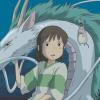 Haku is…Chihiro’s dead brother? Studio Ghibli fans blown away by Spirited Away theory
Haku is…Chihiro’s dead brother? Studio Ghibli fans blown away by Spirited Away theory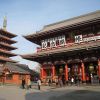 Moving to Tokyo? Real estate agent picks five best neighborhoods for single residents
Moving to Tokyo? Real estate agent picks five best neighborhoods for single residents Disney princesses get official manga makeovers for Manga Princess Cafe opening in Tokyo
Disney princesses get official manga makeovers for Manga Princess Cafe opening in Tokyo Starbucks reopens at Shibuya Scramble Crossing with new look and design concept
Starbucks reopens at Shibuya Scramble Crossing with new look and design concept Beautiful new Final Fantasy T-shirt collection on the way from Uniqlo【Photos】
Beautiful new Final Fantasy T-shirt collection on the way from Uniqlo【Photos】 Is the new Shinkansen Train Desk ticket worth it?
Is the new Shinkansen Train Desk ticket worth it? Foreign English teachers in Japan pick their favorite Japanese-language phrases【Survey】
Foreign English teachers in Japan pick their favorite Japanese-language phrases【Survey】 Japanese convenience store packs a whole bento into an onigiri rice ball
Japanese convenience store packs a whole bento into an onigiri rice ball We try out “Chan Ramen”, an underground type of ramen popular in the ramen community
We try out “Chan Ramen”, an underground type of ramen popular in the ramen community Studio Ghibli releases Kiki’s Delivery Service chocolate cake pouches in Japan
Studio Ghibli releases Kiki’s Delivery Service chocolate cake pouches in Japan Japan’s bone-breaking and record-breaking roller coaster is permanently shutting down
Japan’s bone-breaking and record-breaking roller coaster is permanently shutting down New definition of “Japanese whiskey” goes into effect to prevent fakes from fooling overseas buyers
New definition of “Japanese whiskey” goes into effect to prevent fakes from fooling overseas buyers Our Japanese reporter visits Costco in the U.S., finds super American and very Japanese things
Our Japanese reporter visits Costco in the U.S., finds super American and very Japanese things Studio Ghibli unveils Mother’s Day gift set that captures the love in My Neighbour Totoro
Studio Ghibli unveils Mother’s Day gift set that captures the love in My Neighbour Totoro Foreign passenger shoves conductor on one of the last full runs for Japan’s Thunderbird train
Foreign passenger shoves conductor on one of the last full runs for Japan’s Thunderbird train Domino’s Japan now sells…pizza ears?
Domino’s Japan now sells…pizza ears? New Japanese KitKat flavour stars Sanrio characters, including Hello Kitty
New Japanese KitKat flavour stars Sanrio characters, including Hello Kitty Kyoto creates new for-tourist buses to address overtourism with higher prices, faster rides
Kyoto creates new for-tourist buses to address overtourism with higher prices, faster rides Sales of Japan’s most convenient train ticket/shopping payment cards suspended indefinitely
Sales of Japan’s most convenient train ticket/shopping payment cards suspended indefinitely Sold-out Studio Ghibli desktop humidifiers are back so Totoro can help you through the dry season
Sold-out Studio Ghibli desktop humidifiers are back so Totoro can help you through the dry season Japanese government to make first change to romanization spelling rules since the 1950s
Japanese government to make first change to romanization spelling rules since the 1950s Ghibli founders Toshio Suzuki and Hayao Miyazaki contribute to Japanese whisky Totoro label design
Ghibli founders Toshio Suzuki and Hayao Miyazaki contribute to Japanese whisky Totoro label design Doraemon found buried at sea as scene from 1993 anime becomes real life【Photos】
Doraemon found buried at sea as scene from 1993 anime becomes real life【Photos】 Tokyo’s most famous Starbucks is closed
Tokyo’s most famous Starbucks is closed One Piece characters’ nationalities revealed, but fans have mixed opinions
One Piece characters’ nationalities revealed, but fans have mixed opinions We asked a Uniqlo employee what four things we should buy and their suggestions didn’t disappoint
We asked a Uniqlo employee what four things we should buy and their suggestions didn’t disappoint Princesses, fruits, and blacksmiths: Study reveals the 30 most unusual family names in Japan
Princesses, fruits, and blacksmiths: Study reveals the 30 most unusual family names in Japan Artist recreates famous Japanese ukiyo-e paintings using fine wines
Artist recreates famous Japanese ukiyo-e paintings using fine wines Tokaido ukiyoe series by Hiroshige now free to share, we celebrate with five favourites
Tokaido ukiyoe series by Hiroshige now free to share, we celebrate with five favourites Traditional artisans come together to create ukiyo-e enhanced Rolling Stones merchandise
Traditional artisans come together to create ukiyo-e enhanced Rolling Stones merchandise Video shows incredible process it took to create monstrous model of Godzilla from clay
Video shows incredible process it took to create monstrous model of Godzilla from clay “A dead bug” and other amusing, adorable, snarky, and downright ridiculous test responses
“A dead bug” and other amusing, adorable, snarky, and downright ridiculous test responses Japanese grandpa’s “for fun” ink paintings are so divine they’re now part of a beautiful temple
Japanese grandpa’s “for fun” ink paintings are so divine they’re now part of a beautiful temple Mt. Fuji looks more like a suibokuga painting than real life in this amazing photo
Mt. Fuji looks more like a suibokuga painting than real life in this amazing photo See America through the eyes of Chiura Obata, a Japanese artist from the early 1900s
See America through the eyes of Chiura Obata, a Japanese artist from the early 1900s Ghibli background artist Naohisa Inoue’s painting technique is out of this world
Ghibli background artist Naohisa Inoue’s painting technique is out of this world Make Japanese food replicas at home with the 3-D Dream Arts Pen 【Pics】
Make Japanese food replicas at home with the 3-D Dream Arts Pen 【Pics】 Testing Japan’s gacha capsule toy calligraphy brushes – tranquility for just 200 yen【Photos】
Testing Japan’s gacha capsule toy calligraphy brushes – tranquility for just 200 yen【Photos】 Let beautiful Japanese patterns bloom in your shoes with these insoles from REGALERIA!
Let beautiful Japanese patterns bloom in your shoes with these insoles from REGALERIA! Converse All-Stars team up with two all-stars of Japanese art for Wave, Skull ukiyo-e shoes【Pics】
Converse All-Stars team up with two all-stars of Japanese art for Wave, Skull ukiyo-e shoes【Pics】 Aichi supermarket caught selling poisonous puffer fish livers, “been selling it for decades”
Aichi supermarket caught selling poisonous puffer fish livers, “been selling it for decades”
Leave a Reply